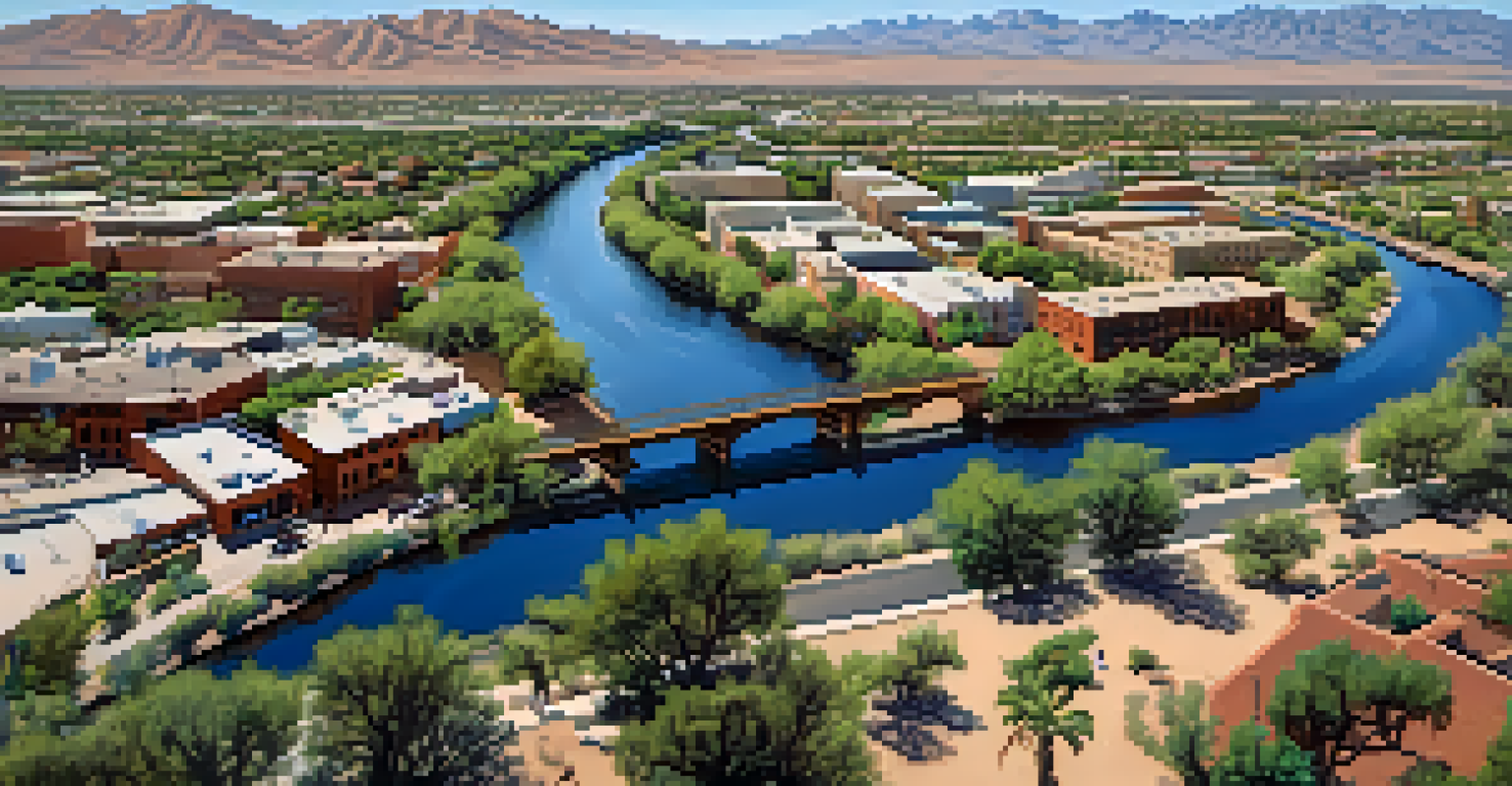The Role of the Santa Cruz River in Tucson's History

The Santa Cruz River: A Lifeline for Early Settlers
The Santa Cruz River has been a vital source of life for the Tucson area since ancient times. Early Native American tribes depended on its waters for agriculture, demonstrating how essential this river was for their survival. The river’s floodplain offered fertile soil, making it an ideal location for cultivating crops like maize and beans.
Rivers are the arteries of our land; they are lifeblood of our ecosystems.
As European settlers arrived, they recognized the river’s significance for irrigation and transportation. They built adobe homes and farms along its banks, turning the area into a thriving community. This connection to the river helped establish Tucson as a key location in the Southwest during the 18th and 19th centuries.
The Santa Cruz River didn't just support agriculture; it also facilitated trade and travel. This strategic advantage attracted various cultures, creating a melting pot that would shape Tucson's identity.
Cultural Significance of the Santa Cruz River
The Santa Cruz River has long been a cultural touchstone for the communities surrounding it. For Indigenous peoples, the river is not only a resource but also a sacred site, representing a connection to their ancestors and the land. This deep spiritual bond continues to influence local traditions and practices today.

As Tucson grew, the river became a focal point for social gatherings, festivals, and celebrations. Events like the annual Dia de los Muertos draw on the river’s rich history, demonstrating how it serves as a backdrop for cultural expression. This ongoing relationship between the river and the people highlights its role in community cohesion.
Santa Cruz River's Historical Role
The Santa Cruz River has been essential for agriculture, trade, and community development in Tucson since ancient times.
The river also symbolizes resilience, reflecting the struggles and triumphs of those who have lived alongside it. Its presence is woven into the fabric of Tucson’s heritage, reminding residents of their shared history and the importance of preserving their cultural roots.
The Changing Course of the Santa Cruz River
Over the years, the Santa Cruz River has undergone significant changes due to urbanization and environmental factors. Once a robust, flowing river, it has been altered by development, flood control measures, and changes in land use. These modifications have raised concerns about the river's health and sustainability.
The health of our rivers is a reflection of our commitment to the environment.
In the mid-20th century, efforts to channelize the river aimed to prevent flooding and manage water resources more effectively. While these measures provided immediate relief, they also led to ecological consequences, including habitat loss for native species. The once vibrant ecosystem began to suffer, prompting calls for restoration.
Today, initiatives are underway to restore the Santa Cruz River to a more natural state. These projects aim to enhance biodiversity, improve water quality, and reestablish the river's role as a vital resource for the community. This ongoing effort highlights the importance of balancing development with environmental stewardship.
Economic Impact of the Santa Cruz River
The Santa Cruz River has played a crucial role in Tucson's economic development throughout history. As a source of water, it supported agriculture, which was the backbone of the local economy for centuries. Farmers relied on the river to irrigate their crops, contributing to the region's food supply and trade.
In modern times, the river continues to influence Tucson's economy through tourism and recreation. The riverbanks have become popular destinations for hiking, biking, and birdwatching, attracting visitors from near and far. This influx of people not only supports local businesses but also fosters a greater appreciation for the natural environment.
Cultural and Economic Significance
The river serves as a cultural touchstone and economic driver, supporting local traditions and tourism.
Furthermore, the river's restoration efforts are seen as a potential catalyst for economic growth. By enhancing the river's recreational value, Tucson can position itself as a desirable location for eco-tourism, which could create new jobs and opportunities for residents. This underscores the river's enduring significance in shaping the local economy.
Environmental Challenges Facing the Santa Cruz River
Despite its historical importance, the Santa Cruz River faces several environmental challenges today. Urbanization has led to pollution and habitat degradation, threatening the delicate ecosystems that rely on the river's health. Additionally, climate change poses risks such as altered precipitation patterns and increased temperatures, which could further impact water availability.
Efforts to mitigate these challenges are ongoing, with local organizations and government agencies working to address pollution and restore habitats. Community engagement is also essential, as residents are encouraged to participate in cleanup events and conservation initiatives. These collective efforts aim to ensure the river remains a vibrant part of Tucson's landscape.
Public awareness campaigns play a crucial role in educating the community about the importance of protecting the Santa Cruz River. By fostering a sense of stewardship, residents can contribute to the river's health and sustainability, ensuring its legacy for future generations.
The Future of the Santa Cruz River in Tucson
Looking ahead, the Santa Cruz River is poised to play an even more significant role in Tucson's future. As more people recognize the importance of sustainable water management, there is a growing commitment to restore and protect this vital resource. This renewed focus may spark innovative solutions to address the challenges it faces.
The river's potential as a recreational and ecological asset is also being explored. With ongoing restoration projects, there is hope that the Santa Cruz River will once again thrive, supporting diverse wildlife and providing spaces for community enjoyment. This vision encourages a harmonious relationship between nature and urban development.
Environmental Restoration Efforts
Ongoing initiatives aim to restore the Santa Cruz River, enhancing its ecological health and community value.
Ultimately, the future of the Santa Cruz River depends on the collective efforts of the community, local leaders, and environmental advocates. By prioritizing sustainability and conservation, Tucson can ensure that the river remains a cherished part of its identity for generations to come.
Community Engagement and the Santa Cruz River
Community engagement has become a cornerstone of efforts to protect and revitalize the Santa Cruz River. Local organizations frequently host events that encourage residents to learn about the river's history and its ecological significance. These initiatives help foster a sense of ownership and responsibility among community members.
Volunteering for river cleanups and restoration projects allows residents to connect with their environment and contribute to its well-being. These hands-on experiences not only enhance the river's health but also strengthen community bonds. When people come together to care for their local environment, they create lasting impacts.

Educational programs in schools and community centers also play a vital role in raising awareness about the river's importance. By teaching the next generation about their natural surroundings, Tucson is nurturing a culture of environmental stewardship that will carry forward. This investment in education is crucial for the river's future.